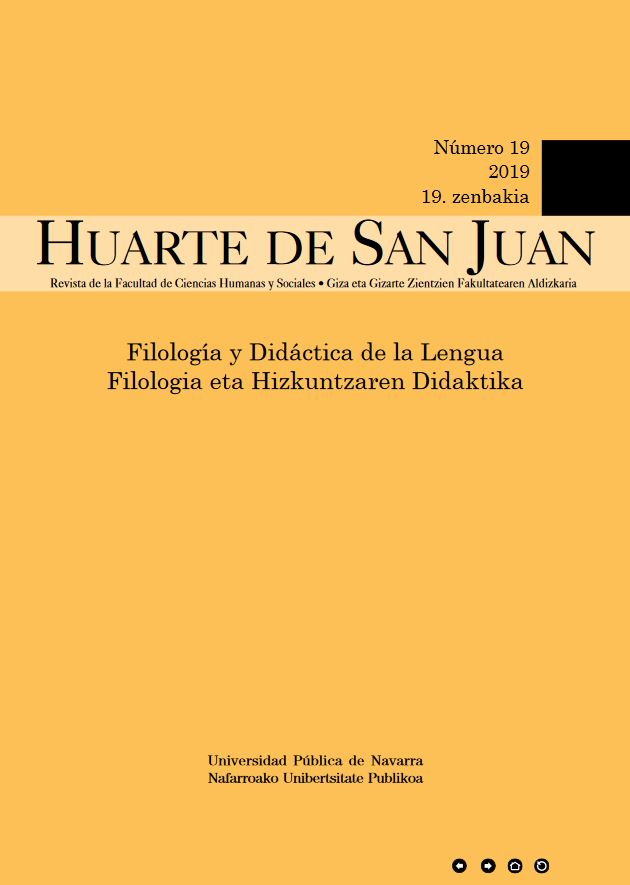The effects of using collaborative writing vs. peer review treatments on subsequent individual writings
Palabras clave:
escritura colaborativa, revisión por pares, corrección, complejidad y fluidez (Me-didas CAF), variedad léxicaResumen
Los efectos tanto de la escritura co-laborativa como de la revisión por pares se han investigado por separado sin comparar ambos enfoques. Este trabajo tiene como objetivo comparar el efecto que estos dos tratamientos tienen en una redacción posterior tomando en consideración la complejidad, la corrección, y la fluidez (Medidas CAF), y además la calidad. 29 estudiantes de nivel de inglés intermedio bajo participaron en este estudio, 16 en el grupo de escritura colaborativa y 13 en el grupo de revi-sión por pares. Se analizaron dos redacciones, una como pre-test y otra como post-test, utili-zando las medidas CAF y una rúbrica análitica. Los resultados sugieren que los estudiantes de la escritura colaborativa escribieron textos más largos y usaron un lenguaje más complejo, mien-tras los de la revisión por pares mejoraron sus redacciones en variedad léxica y corrección
Descargas
Citas
Asberg, P., & Nulden, U. (1999). Making peer review in large undergraduate courses an option. The Viktoria Institute and Department of Informatics, School of Eco-nomics and Commercial Laws, Goteborg University, Sweden.
Ashraf, H., & Mahdinezhad, M. (2015). The role of peer-assessment versus self-as-sessment in promoting autonomy in language use: a case of EFL learners. Irani-an Journal of Language, 5(2), 110
Barnes, D. (1976). From communication to curriculum. London: Penguin Books
Birenbaum, M. (1996). Assessment 2000: towards a pluralistic approach to assess-ment. In M. Birenbaum & F. Dochy (eds.), Alternatives in assessment of achieve-ments, learning processes and prior knowledge (pp. 3-29). Boston, MA: Kluwer Aca-demic Press.
Bygate, M., Skehan, P., & Swain, M. (Eds.). (2001). Researching pedagogic tasks: Second language learning, teaching, and testing. London: Pearson.
Bueno-Alastuey, M. C., & Martínez de Lizarrondo, P. (2017). Collaborative writing in the EFL Secondary Education classroom: comparing triad, pair and individu-al work. Huarte de San Juan. Filología y Didáctica de la Lengua, 17, 254-275.
Cho, K., Schunn, C. D., & Wilson, R. W. (2006). Validity and reliability of scaffolded peer assessment of writing from instructor and student perspectives.Journal of Educational Psychology, 98(4), 891-901.
Coniam, D., & Lee, M. W. K. (2008). Incorporating wikis into the teaching of Eng-lish writing. Hong Kong Teachers’ Centre Journal, 7, 52-67
Cutler, H., & Price, J. (1995). The development of skills through peer assessment, In A. Edwards & P. Knight (Eds.), Assessing competence in higher education (pp. 150-159). Birmingham, Staff and Educational Development Series
Davis, S. (1998). Creative Writing. Forum V, 36(4), 44.
Diab, N. M. (2010). Effects of peer- versus self-editing on students’ revision of lan-guage errors in revised drafts. System, 38, 85-95
Ekşi, G. Y. (2012). Peer review versus teacher feedback in process writing: how ef-fective? International Journal of Applied Educational Studies,13(1), 33-48.
Ellis, R. (2003). Task-based language learning and teaching. Oxford: Oxford University Press.
Ellis, R., & Barkhuizen, G. (2005). Analyzing learner language. Oxford: Oxford Uni-versity Press.
Falchikov, N. (1995). Peer feedback marking: developing peer-assessment.Innova-tions in Education and Training International, 32, 175-187
Fernández Dobao, A. (2012). Collaborative writing tasks in the L2 classroom: Com-paring group, pair and individual work. Journal of Second Language Writing, 21(1), 40-58.
Fernández Dobao, A. (2014). Vocabulary learning in collaborative tasks: A compari-son of pair and small group work. Language Teaching Research, 18, 497-520.
Ferris, D. R. (2003). Response to student writing implications for second language students.Mahwah, NJ: Lawrence Erlbaum Associates, Inc
Freeman, M. (1995). Peer assessment by groups of group work. Assessment and Eval-uation in Higher Education, 20, 289-300
García Mayo, M. P. (Ed.) (2007). Investigating tasks in formal language learning. Cleve-don: Multilingual Matters.
Ghahari, S., & Farokhnia, F. (2018). Peer versus teacher assessment: Implications for CAF triad language ability and critical reflections. International Journal of School & Educational Psychology, 6(2), 124-137
Harmer, J. (2007). How to Teach English. New York: Longman.
Horgan, D. D., Bol, L. & Hacker, D. (1997). An examination of the relationships among self, peer, and instructor assessments. European Association for Research on Learning and Instruction. Athens, Greece.
Hu, G. (2005). Using peer review with Chinese ESL student writers. Language Teach-ing Research,9(3), 321-342.
Hunt, K. (1965). Grammatical structures written and three grade levels. NCTE Research Report, 3. Urbana, IL: The National Council of Teachers of English.
Hunt, K. (1970). Syntactic maturity in schoolchildren and adults.Monographs of the society for research in child development, 35, 134-167
Larsen-Freeman, D. (2006). The emergence of complexity, fluency, and accuracy in the oral and written production of five Chinese learners of English. Applied Linguistics, 27(4), 590-619
Liou, H. C. (2009). A case study of web-based peer review for college English writ-ing. Curriculum & Instruction Quarterly,13(1), 173-208.
Liu, E. Z., Lin, S. S., Chiu, C. H., & Yuan, S. M. (2001). Web-based peer review: The learner as both adapter and reviewer.IEEE Transactions on Education, 44(3), 246-251
Liu, J., & Hansen, J. G. (2002). Peer response in second language classroom. Ann Arbor, MI: University of Michigan Press
Lundstrom, K., & Baker, W. (2009). To give is better than to receive: The benefits of peer review to the reviewer’s own writing.Journal of Second Language Writing, 18, 30-43.
Magin, D., & Helmore, P. (2001). Peer and teacher assessments of oral presenta-tions: how reliable are they? Studies in Higher Education, 26, 287-298.
Mangelsdorf, K. (1989). Parallels between speaking and writing in second language acquisition. In D. M. Johnson & D. H. Roen (Eds.), Richness in writing: Empow-ering ESL students (pp. 134-145). White Plains, NY: Longman
Mendonca, C. O., & Johnson, K. E. (1994). Peer review negotiations: Revision activ-ities in ESL writing instruction. TESOL Quarterly, 28(4), 745-769.
Nassaji, H., & Tian, J. (2010). Collaborative and individual output tasks and their ef-fects on learning English phrasal verbs.Language Teaching Research, 14, 397-419.
Norris, J., & Ortega, L. (2009). Towards an organic approach to investigating CAF in instructed SLA: The case of complexity.Applied Linguistics, 30, 555-578.
Nunan, D. (1989). Designing tasks for the communicative classroom. Cambridge: Cam-bridge University Press.
Ohta, A. S. (2000). Rethinking interaction in SLA: Developmentally appropriate assistance in the zone of proximal development and the acquisition of L2 gram-mar.In J. P. Lantolf (Ed.), Sociocultural theory and second language learning (pp. 51-78). Oxford: Oxford University Press.
Pallotti, G. (2015). A simple view of linguistic complexity. Second Language Research,31, 117-134
Plutsky, S., & Wilson, B. A. (2004). Comparison of the three methods for teaching and evaluating writing: A quasi-experimental study. The Delta Pi Epsilon Journal,46(1), 50-61.
Race, P. (1999). 2000 Tips for lecturers. London: Kogan Page.
Ramsden, P. (1992). Learning to teach in higher education. London: Routledge
Richer, D. L. (1992). The effects of two feedback systems on first year college stu-dents writing proficiency. Dissertation Abstracts International, 53(08A), 2722.
Ruegg, R. (2014). The effect of peer and teacher feedback on changes in EFL stu-dents’ writing self-efficacy. The Language Learning Journal, 46(2) 1-18.
Ruegg, R. (2015). The relative effects of peer and teacher feedback on improve-ment in EFL students’ writing ability.Linguistics and Education, 29, 73-82
Sambell, K., & McDowell, L. (1998). The construction of the hidden curriculum: messages and meanings in the assessment of student learning. Assessment and Evaluation in Higher Education,23(4), 391-402.
Sato, M. (2013). Beliefs about peer interaction and peer corrective feedback: Effica-cy of classroom intervention. Modern Language Journal,97(3), 611-633
Schwartz, M. (1989). Research Associate, for the Learning and Teaching Office. Retrieved from: http://www.ryerson.ca/It.
Shehadeh, A. (2011). Effects and student perceptions of collaborative writing in L2.Journal of Second Language Writing, 20(4), 286-305.
Sluijsmans, D., Brand-Gruwel, S., & Van Merriënboer, J. (2002). Peer assessment training in teacher education, Assessment and Evaluation in Higher Education,27(5), 443-454
Soleimani, H., & Rahmanian, M. (2014). Self-, peer-, and teacher-assessments in writing improvement: A study of complexity, accuracy, and fluency.Journal of Research in Applied Linguistics, 5, 128-148.
Sotillo, S. (2002). Constructivist and collaborative learning in a wireless environ-ment. TESOL Journal, 11(3), 16-20.
Stefani, A. J. (1994). Self, peer and group assessment procedures. In I. Sneddon & J. Kramer (Eds.). An Enterprising Curriculum: teaching innovations in higher education. (pp. 24-46). Belfast: HMSO.
Storch, N. (1999). Are two heads better than one? Pair work and grammatical accu-racy. System, 27, 363-374
Storch, N. (2005). Collaborative writing: Product, process, and students’ reflections. Journal of Second Language Writing, 14(3), 153-173.
Storch, N., & Wigglesworth, G. (2007). Writing tasks: Comparing individual and collab-orative writing. In M. P. García Mayo (Ed.), Investigating tasks in formal language learning (pp. 157-177). London: Multilingual Matters.
Swain, M., & Lapkin, S. (1998). Interaction and second language learning: Two adolescent French immersion students working together. The Modern Language Journal, 82, 320-337.
Swain, M. (2001). Integrating language and content teaching through collaborative tasks.The Canadian Modern Language Review, 58, 44-63.
Villarreal, I., & Gil Sarratea, N. (2019). The Effect of Collaborative Writing in an EFL Secondary Setting. Language Teaching Research.doi: https://doi.org/10.1177/1362168819829017.
Villarreal, I., Bueno-Alastuey, M.C., & Sáez-León, R. (in press). Computer-based collaborative writing with young learners: Effects on text quality. In M.P. García Mayo & A. Imaz, Working collaboratively in second/foreign language learning. Ale-mania: De Gruyter.
Villarreal, I., & Munarriz-Ibarrola, M. (in press). «Together we do better»: The ef-fect of pair and group work on young EFL learners’ written texts and attitudes. In M. P. García Mayo & A. Imaz, Working collaboratively in second/foreign language learning. Alemania: De Gruyter.
Vygotsky, L. S. (1962). Thought and language. Cambridge: M.I.T. Press.
Vygotsky, L. S. (1978). Mind in Society: The Development of higher psychological processes.Cambridge, MA: Harvard University Press.
Watanabe, Y. (2014). Collaborative and independent writing: Japanese university English learners’ processes, texts and opinions. (Unpublished doctoral dissertation). Univer-sity of Toronto, Canada.
Yang, M., Badger, R., & Yu, Z. (2006). A comparative study of peer and teacher feedback in a Chinese EFL writing class. Journal of Second Language Writing, 15, 179-200.
Zhu, W. (2001). Interaction and feedback in mixed peer response groups. Journal of Second Language Writing, 10(4), 251-276.
Descargas
Publicado
Cómo citar
Número
Sección
Licencia
Todos los artículos son publicados bajo una licencia de uso y distribución Creative Commons (BY-NC-ND 4.0). A cada artículo se le asignará un identificador DOI.
Los autores conservan los derechos de autor y conceden a la revista el derecho de la primera publicación. Los autores podrán establecer acuerdos adicionales para la distribución no exclusiva de la versión de la obra publicada en la revista (por ejemplo, situarlo en un repositorio institucional), con un reconocimiento de su publicación inicial en esta revista. Los trabajos podrán subirse a repositorios institucionales inmediatamente tras la publicación de la revista.
Asimismo, se permite y se anima a los autores a difundir sus trabajos electrónicamente (por ejemplo, en repositorios institucionales, redes sociales académicas o en su propio sitio web).







